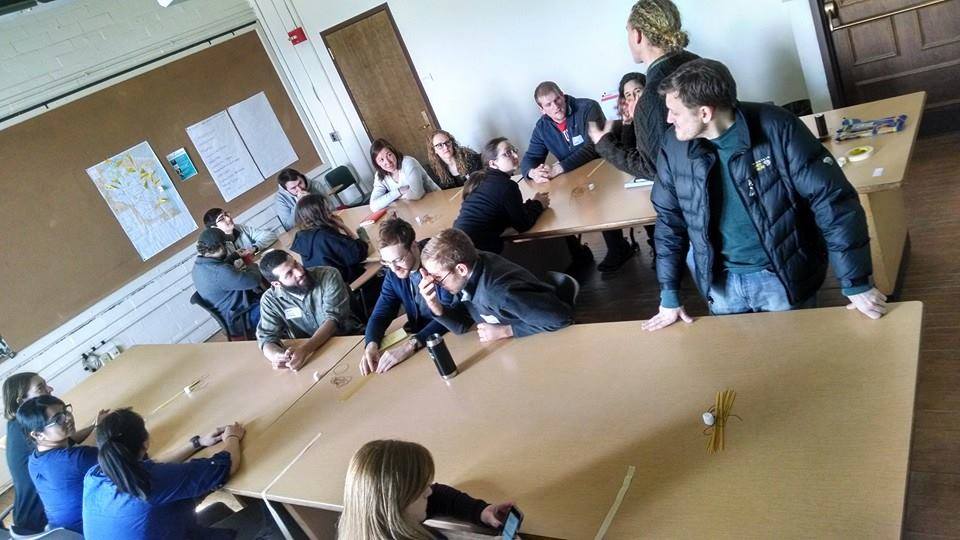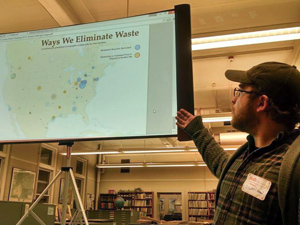Geography students participate in day of intense professional development
 Eighteen geography students spent their Valentine’s Day wading through a complicated, real-world dataset, to create data visualizations that will help researchers better understand the hazardous waste trade in North America. Dr. Sarah Moore obtained EPA records of transnational trade of hazardous waste through a pair of Freedom of Information Act requests. The data are big and messy, and real. They arrived as scans of shipping labels, which had to be coded. Students over the course of two semesters have worked to code the data, putting it into a format that can be analyzed. With a little over a quarter of the data entered, it was time to start digging around to see what stories could be unearthed.
Eighteen geography students spent their Valentine’s Day wading through a complicated, real-world dataset, to create data visualizations that will help researchers better understand the hazardous waste trade in North America. Dr. Sarah Moore obtained EPA records of transnational trade of hazardous waste through a pair of Freedom of Information Act requests. The data are big and messy, and real. They arrived as scans of shipping labels, which had to be coded. Students over the course of two semesters have worked to code the data, putting it into a format that can be analyzed. With a little over a quarter of the data entered, it was time to start digging around to see what stories could be unearthed.

A mix of undergraduate, graduate, and GIS certificate students showed up early on a Saturday morning to work with a dataset that no one else has looked at. Patterns, trends, anomalies discovered by the students were the first of their kind! To succeed, it required the students to push their technical abilities, learn from experts in the room, and trust their instincts. In the end they gained confidence that they are ready for work after school, because of all that they have experienced as students in the UW-Madison Geography Department. Graduate students Heather Rosenfeld and Rafi Arefin, who worked with Dr. Moore to develop the dataset, were among the panel of experts available to students in the nearly 12 hour exercise. Other faculty and staff were on hand to work directly with students, coaching and teaching as the day progressed. Dr. Moore, Dr. Rob Roth, Tanya Buckingham, Assistant Director of the Cartography Lab, and Daniel Huffman, cartography lecturer, challenged students to dig deep into the data, and think about it in new ways. Erik Steiner, a special guest from Stanford’s Center for Spatial and Textual Analysis, joined the team to assist in big picture thinking, technical help, and the popular marshmallow challenge, which provided a much-needed break mid-day.
We hosted this event because the best way to learn about design is by designing (a philosophy held near and dear to the experiences of our students in the lab spaces throughout the department). A design challenge gives students a focused, “lock-in”-like experience that mimics the daily design constraints that they will experience in the real world. The intended result was a portfolio piece and design experience that students can discuss with prospective employers. A design challenge gives students an opportunity to test themselves–to tinker, fail, and overcome–and ultimately to demonstrate how far they’ve come as a designers to-date and to diagnose current limitations as they turn themselves into well-round professionals. Finally, a design challenge is a community building opportunity; strengthening the amazing community of faculty, staff, graduate, and undergraduate students across the disciplines of geography within our department.

At the end of the day the students were required to present what they had discovered and created. The audience, and the panel of experts were impressed by the quality of the output. Dr. Moore expressed gratitude for new perspectives on the data. The most profound insight was provided by the weary students, and was exemplified in the statement made by the first presenter. When asked, “What did you learn today?” she proclaimed, “I learned that I can make this in eight hours!” and proudly pointed to her map on the screen. The collaboration throughout the day was so strong that when the students were to select a winning team for support and spirit of the day, the response was overwhelmingly to split the accolades for the category amongst all of the teams.
This event was one in a series of professional development activities offered to UW-Madison Geography students this year, and is in alignment with an annual event to bring the experts to our students for hands-on activities. The Design Challenge was made possible through an incubator grant from the Mellon Foundation to Moore and Roth on the topic of “spatial humanities.” The grant provided food throughout the day, funding for Steiner (also a speaker at that week’s Yi-Fu Tuan Lecture), two additional Yi-Fu speakers, and $800 in cash prizes for the winners of the competition.



